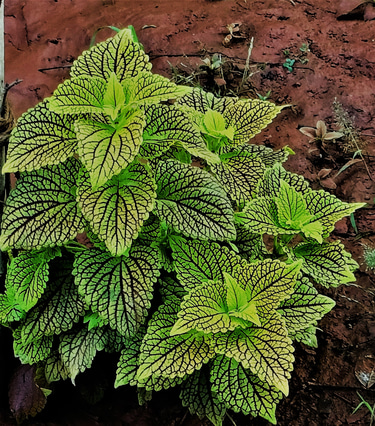Diseases and pests of Rose Plant
Rose is a flower known for its elegance and fragrance, used to convey our deep emotions. Rose Cultivated world wide either at kitchen garden or in large scale for commercial purposes.
CROP CULTIVATION
Satish Naik
9/7/202310 min read

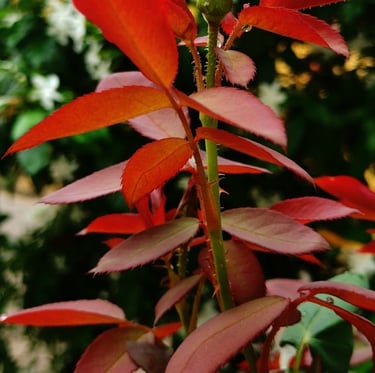
Diseases and pests of Rose Plant
Rose is a flower known for its of elegance and fragrance. It is the one which is used for convey emotions like love, admiration, gratitude, honor, desires and others. It is mandatory plant in kitchen garden to improve its ambience and cultivated commercially in large scales in open fields or green houses as well. Flowers are of various attractive colors, may be red or yellow or pink or white. Cultivation of rose dates back to 5000 years, probably started in China. According to fossil evidences rose is 35 million years old.
There are many disease affecting and many insects infesting the rose plants troubling the rose gardeners. Some of them singly or in combination with others are proved devastating to cause huge loss in flower production. Aboitic and biotic stresses induced hazards are also very common in rose cultivation. These tresses may be associated with insufficient nutrients availability, problems in absorption of nutrients due to pH factors, excess or scarcity of water, climate induced stresses like high humidity or prolonged arid climates. Under such situation plants becomes more vulnerable to incidence of diseases. The diseases may be fungal or bacterial or of nematodes or viral. Some times in combination of more than one pathogen find it very difficult to manage and needs sustained efforts. Having enough knowledge and ability to identify them in early stages and taking up suitable control measure is essential for successful and profitable rose cultivation.
Diseases of Rose:
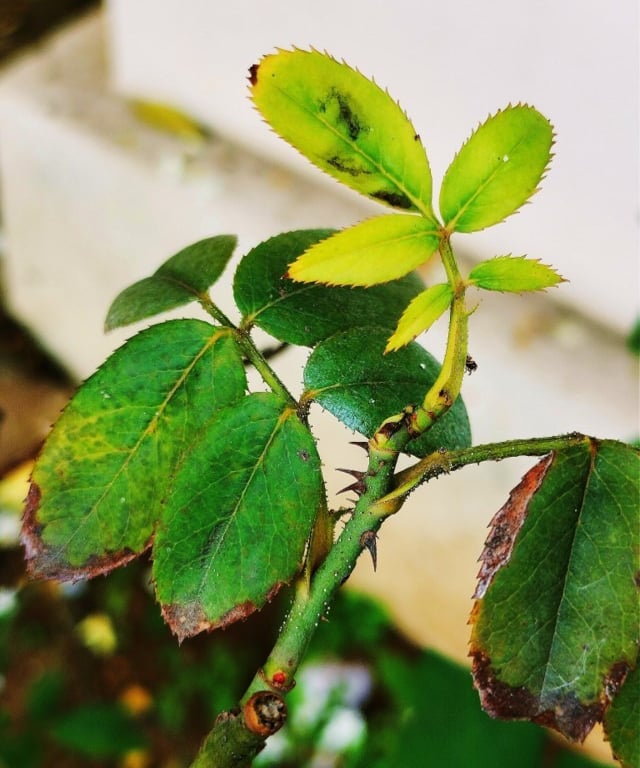
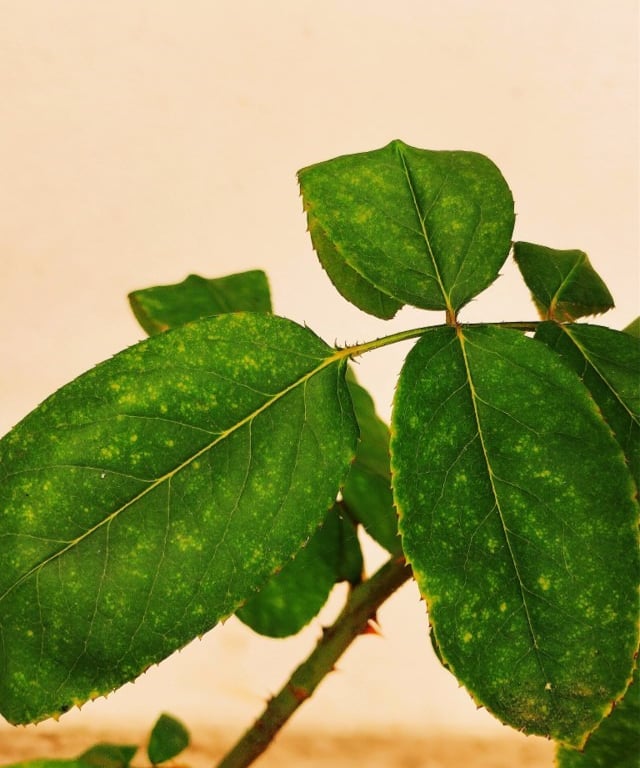
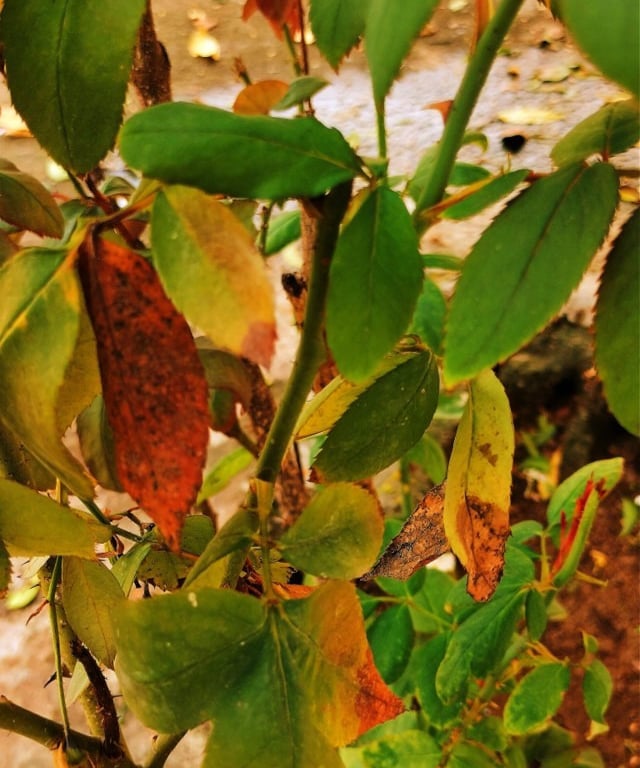
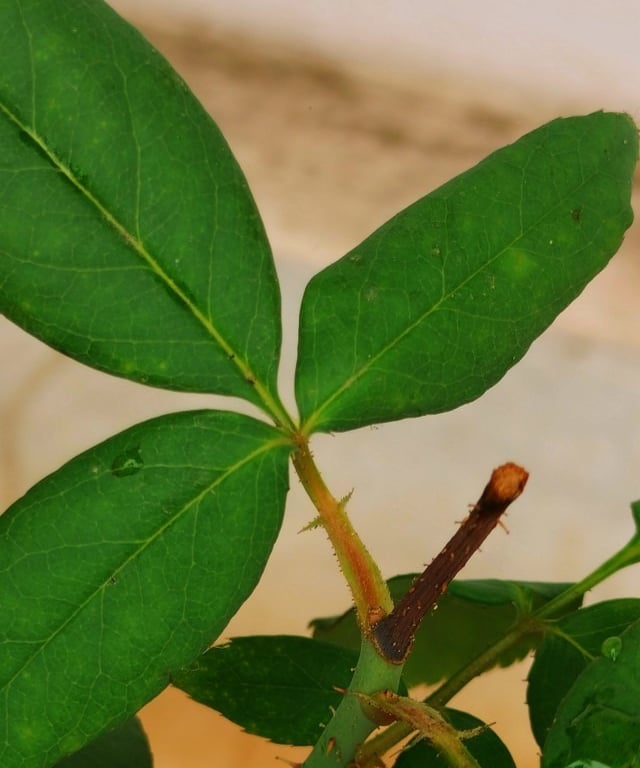
Important diseases affecting the rose garden are Rust, Die back, Black spot, Powdery mildew, Anthracnose, Mosaic, Rosette.
Rust
Powdery mildew:
Powdery mildew is a disease caused by fungus Sphaerotheca pannosa. The disease is symptomatics of grayish white powdery substances appear on young leaves, shoots and buds. Infected leaves may distort and twist, dry and fall. Infected buds fail to open properly and produce distorted flowers. Fungal spores continue to develop even on petals and sepals of the flowers.
Management: Providing enough space between plants and frequent pruning of plants to allow enough sunlight to reach entire plant. Because conidia do not survive when exposed to prolonged sun light. Presence of sunlight reduces the humidity around the plants. Avoiding watering over the plants, control of weeds, providing proper drainage to avoid water stagnation are very essential practices to perform. Use the suitable fungicide at right time and dosage if disease is alarming.
Rust is also a fungal disease, caused by Phragmidum mucronatum. The disease is characterized by formation of orange yellow pustules on lower surface of the leaves and sometimes on stems. In advance conditions pustules turn into brownish red. Affected plants shows yellowing of leaves, deformed buds and flowers and die back. Leaves fall off prematurely. Disease is very common in cooler climate and in shady areas. High relative humidity , lower temperature and shorter day length favors the pathogens.
Management: Rust causing fungus are biotrops which survive only in living tissues. In the absence of living cells they under go dormancy. Best way to control the disease is to collect and destroy the diseased parts. Avoid excess watering and overhead watering.
Black spot of Rose:
Diplocarpon rosae is the fungal pathogen causing black spot disease in rose. It is the most important disease in rose garden. Feathery edged black spots appear on lower leaves and later spread to younger one and stems. Red or purple blotches on first year canes is also a very common symptoms. Affected leaves turn yellow and drop off. Cool and moist climate, keep the leaf surface watery for longer period favors the disease occurrence and its spread.
Management : Pruning of affected plant parts and collection of affected leaves and destroy to avoid spread of disease. Ensure proper sanitation and weeding in the garden. Use suitable fungicide in advanced stage controls the disease significantly.
Die back disease:
Die back in rose plant is caused by fungal pathogen Diplodia rosarum. In this case, twigs of rose plant start drying at the tip which extend downward. Affected twigs start drying first and entire plant in advanced conditions. Die back symptoms occur either on branch or on main stem. If the plants undergo stresses like excess or poor watering, lack of nutrient, continuous dry spell may induce die back in association with pathogens. Any cut or wound on the stem may gain entry of fungus causing die back and later keep spreading adjacent tissues if left untreated.
Management: Dead portion of the cane is to be pruned and destroyed. Care should be taken to treat the cut end of the stem with suitable fungicidal paste. Equipment used for pruning should be sanitized before using to avoid any kind of fungal infection and spread.
Anthracnose of Rose:
It is caused by fungus Elsinoe rosarum. Main symptom of anttracnose is formation of leaf spots which are red or brown initially and turn into larger spots with gray or whitish center and reddish margin later on. Affected portion may dry and fall, leaving shot holes on leaves. Extended humid climate favors the disease incidences.
Management: Frequent pruning to ensure proper sun light reaching entire plant. Destroy alternate host by weeding. Avoid wetting of leaves for a longer period by overhead watering.
Rose mosaic disease:
Rose mosaic is a viral disease, caused by rose mosaic virus. Small pale yellow spots, cluster of dots, rings or streaks are the visible symptoms of this disease. Like any other virus disease leaves show puckering or distort and upward curling. Plant may produce small sized and lesser number of flowers.
Management: Use of disease free propagating materials. Uprooting and destroying entire affected plant.
Rose rosette disease:
Rose rosette disease is associated with the production of excess lateral branching with short inter nodes, thorns and leaves. Plant fail to produce any flower in this condition. This disease is transmitted by eriophyid mites, phyllocoptes fructiphilus. Management is similar to that of rose mosaic disease.
Root Knot Nematode:
Botrytis Blight
Botrytis cinerea is the fungus causing the said disease. Symptoms are small blisters or spots on buds and flowers. Flowers fail to open properly. In advance conditions plant show retarded growth.
Management : It is necrotrophic fungi, can survive in dead tissues. Thus collection of plant debris and the destruction of the same is very important. Frequent pruning to remove diseases and dead branches are also use full. Avoid use of excess nitrogenous fertilizer may be a vital.
Nematodes like Meloidogyne Species may attack to rose roots. Under infested condition rose plant show stunted growth, yellowing of leaves and wilting. These nematodes forms galls on the roots and affect the ability of the root absorb water and nutrients.
Management: Nematodes can be controlled effectively by using Neem extract. . Application of Neem cake to soil may take care of nematode problem to greater extent. Defending on the severity of infestation nematicides can be used.
Pests of rose plants
Rose slugs, Rose chafers, Metallic flea beetles, Leaf cutter bees are minor insect pests feeding on rose plants, may not cause much damage, except some nuisence.
Rose slugs: Other wise known as Saw flies. They lay eggs on leaves or stems of the plant using saw like ovipostor. The pale green larvae of half an inch length with hairy bristles all over the body, may find feeding on leaves staying underside. Hand picking of larvae and use of any insecticide may take care of the insects.
Rose chafer: Macrodactylus subspinosus and Cetonia aurata are beetles, feed on foliage, petals and buds. Their grubs feed on roots. Some time they appear in swarm and feed on foliage. Application of any mild dosage of insecticide or soapy water or bio insecticides may mitigate the problems.
Metallic flea beetle: These insects chew holes on leaves in irregular shapes. These are small brightly colored jumping kind of beetles feed on leaves. Keep the garden free from debris and trashes may helpful to control flea beetle infestations.
Leaf cutter Bees: They are otherwise known as Megachilid bee or mason bee. These are solitary bee and feed on leaves by cutting circular holes. They dwell on rotten wood, pith area of plant. Removing of such area helps to keep bees away.
Aphids, Thrips, scales, Mealy bugs, Red spider might, beetles, termite are the some of the important insect pests to be encountered during rose cultivation.
Aphids:
Thrips:
These are tiny insects, suck the sap from tender shoots. They find hiding inside the buds and under petals causing damage there. They have the ability to multiply fast and reach to alarming number to cause economic damage at faster rate. Affected parts become withered, flowers and buds shows fading, distorted, spotted. Inner petals of the flowers remain unopened.
Management: Thrips are managed effectively by the spray of horticultural oils, insecticidal soap solutions, use of natural pyrethrums. Presence of natural enemies like Lady Bird Beetles, wasps and Preying Mantids reduces the thrips populations.
Red Spider Mite:
Red Spider mites of species like Tetranychus cinnabarinus and Tetranychus utricae are found infesting rose plants. They remain under side of the leaf, hiding inside the silken web feeding on leaves. They feed on leaves in pockets and affected portion of leaves shows yellow or brown spot and feeding punctures. In severe condition leaves fall off to affecting the growth and yield. Whitish, spherical shaped eggs are noticed on upper surface of leaves and later hatch to produce red colored nymphs and adults. These spider mite complete life cycles with in week and appear through out the year.
Management: Spraying with insecticidal soaps, horticulture oil mitigate the number to the great extent. Care should be taken to spray reach the under side of the leaves.
Rose scale:
Rose Aphids ( Macrosiphum rosaeformis D. M rosae), Cotton Aphids (Aphis gossypii Glover) and Peach Aphids ( Myzus persicae) are the three important aphid species affecting rose plants. Adults and nymphs gather at the tip of tender shoots, flower buds and flowers and suck the sap from there. Withering of tender shoots and deformed buds and flowers which may fall off prematurely are the results of infestations. They exudes sugary substance that forms sooty mold on affected portions. These aphids may vector some of the viral diseases like mosaic and rosette in rose.
Management: Encourage the growth of natural enemies like lady bird beetles, Green lace wing's larvae ( Chrysoperia rufilabris), parasitic wasps (Aphidius species) which feed on aphids. Avoid application of high level of nitrogenous fertilizer which increases the plant succulency to attract aphids. Use of insecticidal soaps, horticultural oils also helpful to control these sucking pest.
Presence of scales can be identified by formation of small bumps on stems. These bumps are the waxy shells inside of which the scales survive. usually scales form large colony covering entire stem and stay sucking the sap there. These are immobile insects. Sucking of sap from stem leads to withering of plant parts and die back.
Management: Pruning and destroying the affected plant portion is very essential. Keeping the garden weed free is equally important. Encourage the visit of natural predators like lady bird beetles and wasp to keep the scales in hunt.
Rose Beetle
Rose beetles are scientifically known as Naupactus godmanni. These insects feed on foliage and petals leaving wavy or notched edges. Eggs are laid in soil and grubs on hatching start feeding on roots. These beetles have very broad host range.
Management: Spray of neem oil over plant and application of Neem cake to soil may prevent both adult and grubs from feeding on rose plant. Both act as anti-fedent which prevent the beetle feeding from rose plant.
Japanese Beetles:
Japanese beetles ( Popillia japonica) is another beetle which causes damages in rose plantations. Here adult is devastating at times. They emerge from ground in large number and may skeleton the plant by feeding content in between leaf veins. . Larvae hatch in soil and feed on roots. It has distinguished copper colored elytra and greenish thorax and head.
Management: Spray of neem oil will and application neem cake to soil reduce the beetle population.Use of soap water spray or insecticidal soap solutions also may minimize the problems. Use of milky spores, a bacterial culture has been found beneficial in controlling these beetles.
Minor Insect pests:
Termites:
Termites or white Ants, scientifically known as Odontotermes obesus are also found attacking rose plants. They remain in soil and feed on roots and stem causing withering and drying of plants. Termites are white, soft bodied insects.
Management: Disposal of debris and trashes, deep summer plouhing, destruction of termite bunds are very useful practices to manage the this pest. Seed treatment with chlorpyriphos @ 4ml/ kg of seed has been found effective.
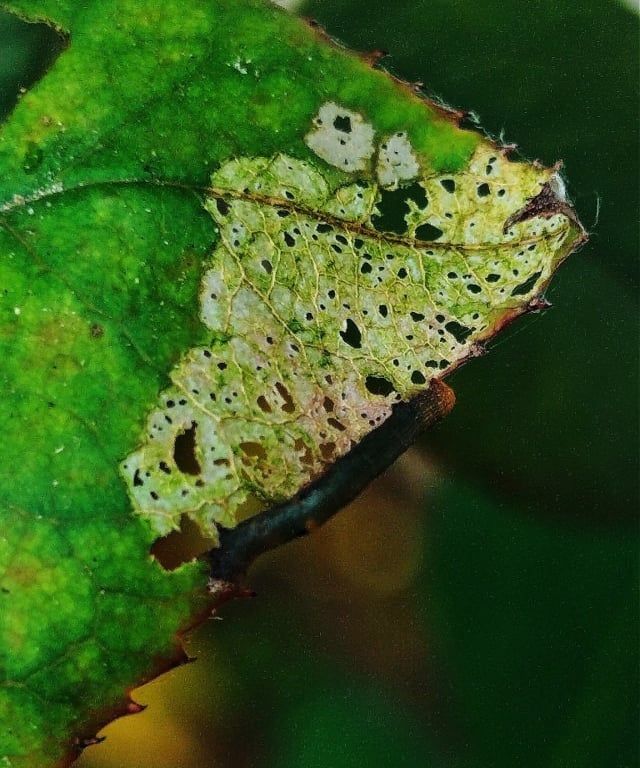
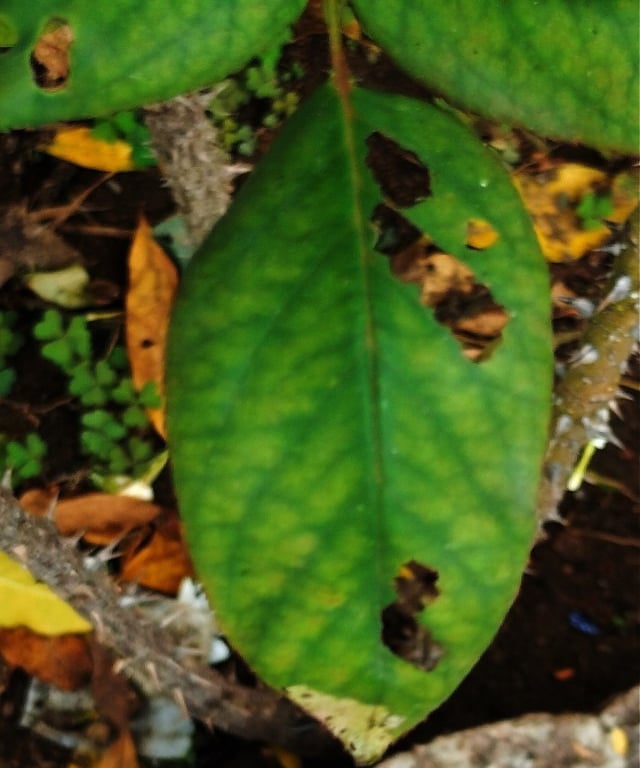
Some of the preventive measures may help to great extent to minimize the efforts , energy and expenditures in managing the pest and diseases in rose cultivation. Some of the precautions like selection of site not having history of diseases especially soil born fungus or nematodes is primary requisite. Site selected to be provided with drainage facilities to avoid water logging. Removal of debris of older crops and breaking the clods by tilling will be helpful. Keeping the garden free from weeds may deprive of pathogens and insects for alternate hosts. Taking care of all required nutrients and timely watering helps to keep the plants healthy and maintain vigor make them less susceptible disease attack. Integrating the different control measures reduces cost of cultivation and conserve the soil and environment and sustained flower production for longer period of time. Ample use of organic matters which keeps soil fauna intact. Pruning of plants timely which allows the sun light and air reaching entire plant are very beneficial. Care should be taken to use clean and sanitized equipment's while pruning. Chemical control to be undertaken in such way that, it should not affect beneficial insects. Rotation of fungicides or insecticides plays a vital role to reduce possibilities of resistance development.
Newsletter
Sign up for our newsletter and get notified about all new posted articles.
ADDRESS
House No. 2-113(P), Visnumurthynagar, Kelarkalabettu, Thenkanidiyuru, Udupi
cONTACT
7975809540
satishmqc362@gmail.com
